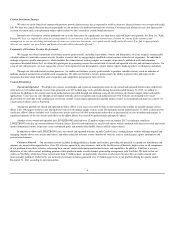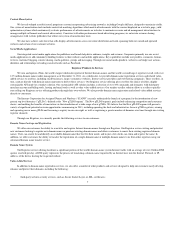Enom 2011 Annual Report Download - page 20
Download and view the complete annual report
Please find page 20 of the 2011 Enom annual report below. You can navigate through the pages in the report by either clicking on the pages listed below, or by using the keyword search tool below to find specific information within the annual report.
could limit the effectiveness of our content creation process, which would have a material adverse effect on our business, financial condition and results of
operations. In addition, new laws or changes to existing laws in this area may prevent or restrict our use of this data. In such event, the value of our algorithms
and our ability to determine what consumers are seeking could be significantly diminished.
If we are unable to attract new customers for our social media applications products or to retain our existing customers, our revenue could be lower than
expected and our operating results may suffer.
Our enterprise-class social media tools allow websites to add feature-rich applications, such as user profiles, comments, forums, reviews, blogs,
photo and video sharing, media galleries, groups and messaging offered through our social media application product suite. We also provide social media
services by powering live events with social engagement tools. In addition to adding new customers for our social media products, to increase our revenue, we
must sell additional social media products to existing customers and encourage existing customers to maintain or increase their usage levels. If our existing
and prospective customers do not perceive our social media products to be of sufficiently high quality, we may not be able to retain our current customers or
attract new customers. We sell our social media products pursuant to service agreements that are generally one to two years in length. Our customers have no
obligation to renew their contracts for our products after the expiration of their initial commitment period, and these agreements may not be renewed at the
same or higher level of service, if at all. In addition, these agreements generally require us to keep our product suite operational with minimal service
interruptions and to provide limited credits to media customers in the event that we are unable to maintain these service levels. To date, service level credits
have not been significant. Moreover, under some circumstances, some of our customers have the right to cancel their service agreements prior to the
expiration of the terms of their agreements, including the right to cancel if our social media product suite suffers repeated service interruptions. If we are
unable to attract new customers for our social media products, our existing customers do not renew or terminate their agreements for our social media
products or we are required to provide service level credits in the future as a result of the operational failure of our social media products, then our operating
results could be harmed.
Wireless devices and mobile phones are increasingly being used to access the Internet, and our online marketing services may not be as effective when
accessed through these devices, which could cause harm to our business.
The number of people who access the Internet through devices other than personal computers has increased substantially in the last few years. In
general our Content & Media services were designed for persons accessing the Internet on a desktop or laptop computer. The smaller screens, lower resolution
graphics and less convenient typing capabilities of these devices may make it more difficult for visitors to respond to our offerings. In addition, mobile
advertising yields are currently frequently lower than those on other devices. We must also ensure that our licensing arrangements with third-party content
providers allow us to make this content available on these devices. If we cannot effectively make our content, products and services available on these
devices, fewer consumers may access and use our content, products and services. Also, if our services continue to be less effective or economically attractive
for customers seeking to engage in advertising through these devices and this segment of Internet traffic grows at the expense of traditional computer Internet
access, we will experience difficulty attracting website visitors and attracting and retaining customers and our operating results and business will be harmed.
We are dependent upon the quality of traffic in our network to provide value to online advertisers, and any failure in our quality control could have a
material adverse effect on the value of our websites to our third-party advertisement distribution providers and online advertisers and adversely affect our
revenue.
We use technology and processes to monitor the quality of, and to identify any anomalous metrics associated with, the Internet traffic that we
deliver to online advertisers and our network of customer websites. These metrics may be indicative of low quality clicks such as non-human processes,
including robots, spiders or other software; the mechanical automation of clicking; and other types of invalid clicks or click fraud. Even with such monitoring
in place, there is a risk that a certain amount of low-quality traffic, or traffic that is deemed to be invalid by online advertisers, will be delivered to such online
advertisers. As a result, we may be required to credit future amounts owed to us by our advertisers. Furthermore, low-quality or invalid traffic may be
detrimental to our relationships with third-party advertisement distribution providers and online advertisers, and could adversely affect our revenue.
The expansion of our owned and operated websites into new areas of consumer interest, products, services and technologies subjects us to additional
business, legal, financial and competitive risks.
An important element of our business strategy is to grow our network of owned and operated websites to cover new areas of consumer interest,
expand into new business lines and develop additional services, products and technologies. In
16
























